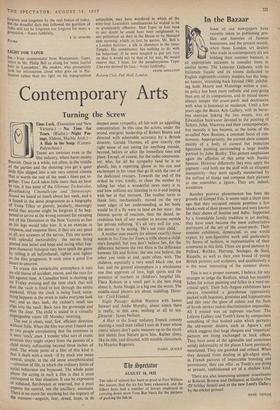In the Bazaar
SOME of our newspapers have recently taken to publishing pro- files and histories of famous businesses, and the present season, when those London art dealers who trade in contemporary art are holding their summer bazaars, is an appropriate occasion to consider them in similar terms. The Leicester Galleries, with its Italianate facade and its rooms dedicated to English eighteenth-century masters has the long- est history, stretching back beyond 1900; exhibit- ing both Moore and Munnings within a year, its policy has been more catholic and easy-going than any of its companions, and its mixed shows always temper the avant-garde and doctrinaire with what is historical or moderate. Until a few years ago the Beaux Arts Gallery, with its horse- bus staircase linking the two rooms, was an Edwardian backwater devoted to the painting of Sickert, John, Macevoy and their contemporaries, but recently it has become, as the home of the so-called New Realists, a constant focus of con- troversy. Appropriately, the current show consists mainly of a body of earnest but immature figurative painting surrounding a large double portrait by John Bratby. This picture emphasises again the affinities of this artist with Stanley Spencer. However differently they may apply the pigment—and both use the stuff with an eloquent insensitivity—they seem equally mesmerised by the surface of things and compose their pictures as one assembles a jigsaw. They are, indeed, eccentrics.
Another postwar phenomenon has been the growth of Gimpel Fils. It seems such a short time ago that they occupied minute premises a few blocks west of their present home and were known for their shows of Soutine and Adler. Supported by a formidable family tradition in art dealing, they have since become the most authoritative purveyors of the art of the avant-garde. Their summer exhibition, dominated, as one would expect, by non-figurative work and particularly by forms of tachism, is representative of their command in this field. There are good pictures by Pollock, Rothko, Hartung, Soulages, de Stael, Riopelle, as well as their own brood of young British painters and sculptors, and qualitatively it is the most interesting of the summer shows.
This is not a proper moment, I believe, for any stranger to judge the Redfern, which has recently fallen for action painting and fallen in a most un- critical spirit. Their July-August exhibitions have always resembled a greenhouse oppressively packed with begonias, gloxinias and hippeastrums and this year the glare of colour and the flash of brush strokes makes discrimination impossible. All I missed was an espresso machine. The Lefevre Gallery and Tooth's have by comparison something of that hushed calm which pervades the old-master dealers, such as Agnew's, and which suggests that large cheques and 'important' pictures are being exchanged in back offices. They have none of the agreeable and sometimes untidy informality of the places I have previously mentioned. They are guarded and refined. When they descend from dealing in gilt-edged stock, in French pictures of impeccable breeding and provenance, they can offer, as Tooth's are doing at present, sophisticated art of a shallow kind.
There are also interesting summer miscellanies at Roland, Browse and Delbanco, at Gallery One (D'Arblay Street) and at the new Lord's Gallery by the cricket ground.
BASIL TAYLOR






























 Previous page
Previous page